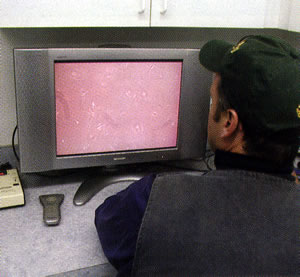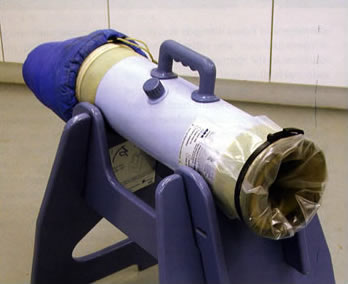Broodmare and Stallion
Reproductive Management Techniques
- An Overview
Introduction
The purpose of this article is to give the reader an abbreviated
summary of broodmare and stallion reproductive management techniques. While
it will give an overview of current management practices, equine reproductive
management is a field in which scientific investigation is ongoing and advancing
steadily. New information, gleaned from the use of advanced techniques in
molecular/cellular biology and endocrinology, is improving our understanding
of the basic science of how the horse reproduces itself. Using this information,
new techniques in the field known as "assisted reproduction" or
"AR" emerge and are made available to help broodmare and stallion
owners and managers.
What is
"assisted reproduction"?
In short, the ways in which we humans intervene in, and hopefully
improve, the reproductive processes of many species comprise the field of
Assisted Reproduction (AR). These include techniques such as artificial insemination,
transported semen, embryo collection and transfer, gamete (sex cell) and embryo
preservation, and fertility/infertility management. While many of these techniques
were first developed for species other than the equine, horse breeders quickly
recognized the potential value of

AR allows us to improve the reproductive efficiency of our
mares and stallions, allowing them to reproduce more reliably, frequently,
safely and over a greater portion of their lifetime. Using these powerful
techniques, we can extend our horse's reproductive lifespan —even beyond their
passing.
A Very Brief Overview of Basic Mare Reproductive Physiology
Before discussing AR techniques, a bit of background on mare reproductive
physiology is in order. The mare's reproductive tract consists of the vagina,
cervix, uterus and two ovaries. It's basic purpose is
to provide the environment, as well as the mare's genetic contribution— the egg
(or "oocyte"), in which conception can
occur and the resulting embryo can develop until it is capable of living on the
outside. Mares are "seasonal breeders" — typically during the spring
and summer months of March through September (in the northern hemisphere).
During these months, the normal mare will cycle with an average of 19 to 21
days between ovulations. Each cycle can be divided into at least two distinct
periods: diestrus and estrus.
 Diestrus follows ovulation and lasts around 14 days.
During diestrus, the mare's cycle is primarily under
the influence of progesterone and she is externally and internally unreceptive
to the stallion. Externally, she exhibits aggressive behavior toward an interested
stallion, strongly discouraging him from any attempt to breed her. Internally,
her cervix (which is the passageway between the vaginal vault and the uterus)
is tightly closed and is therefore impenetrable by semen. Her ovaries are
only in the early stages of developing "follicles"— fluid-filled
capsules containing a single egg.
Diestrus follows ovulation and lasts around 14 days.
During diestrus, the mare's cycle is primarily under
the influence of progesterone and she is externally and internally unreceptive
to the stallion. Externally, she exhibits aggressive behavior toward an interested
stallion, strongly discouraging him from any attempt to breed her. Internally,
her cervix (which is the passageway between the vaginal vault and the uterus)
is tightly closed and is therefore impenetrable by semen. Her ovaries are
only in the early stages of developing "follicles"— fluid-filled
capsules containing a single egg.
The dominant follicle(s) will mature to approximately 35-50
mm in diameter, undergo maturational changes in response to the hormone LH,
and ovulate at approximately day 20. A mare will typically remain receptive
to the stallion for at least 12 hours after ovulation, during which time she
is still fertile.
How can we control a mare's cycle?
Because the natural onset of cycling in early spring is the
result of increased perception of light due to increased daylength,
we can artificially hasten the onset of cycling by putting a mare "under
lights" in early December.
A typical stall lit with a 120-200W bulb at
This allows the mare to be bred for an early January foaling
date. While this is not an ideal time of the year to foal a mare, many breed
registries dictate January 1 to be the "birthday" of their member
horses. Young horses competing in weanling, yearling and two-year-old events
are at a distinct advantage if they are born earlier in the year.
This diestrus phase of a mare's cycle
can be shortened by approximately one week by administering a lutealytic agent which ablates the corpus luteum, the ovarian gland responsible for progesterone production
during diestrus.
This is sometimes done at the mare owner's request in order
to shorten a mare's stay at a breeding facility or to synchronize the cycles
of several mares so that they may be bred at approximately the same time.
Conversely, some mares are given supplemental progesterone during diestrus to prolong diestrus, also
to aid in the synchronization of multiple mares or to provide additional hormonal
support during early gestation.
Induction of Ovulation
As a dominant ovarian follicle matures during the estrus phase
of a mare's cycle, it develops the ability to "see" leuteinizing hormone, or LH by developing receptors for this
protein hormone. LH is the hormone signal responsible for triggering the final
maturational changes which a follicle must undergo prior to ovulation. The
egg within the follicle must also undergo changes in order to be capable of
normal fertilization and subsequent embryonic development. A mare will naturally
produce LH and initiate this process on her own.
We can, however, exert some control on this process ourselves
through the use of human chorionic gonadotropin or "hCG".
hCG looks, structurally, like LH
and therefore is able to trigger the same physiologic response by binding
LH receptors associated with the follicle. A mare will generally ovulate within
36-48 hrs of hCG administration
as long as the follicle has developed the receptors to "see" it.
This is generally the case after 4 days of estrus and a dominant follicle
35 mm or larger in diameter. By intervening in the mare's cycle with hCG,
we can control when she ovulates to better coincide with a stallion's breeding
schedule, a frozen semen breeding protocol, synchronization of several mare's
ovulations, even our own schedules. Induction of ovulation is commonplace
in today's breeding facilities.
Artificial insemination refers to the process of introducing
semen into the uterus manually, without a natural breeding. Semen is collected
from a stallion using an artificial vagina (AV) and is transferred into a
mare's uterus via a long pipette which is passed through the cervix and into
the uterus.
Advantages of an artificial insemination program include:
1) decreased risk of injury to mares, | stallions and handlers 2) the ability
to breed multiple mares with semen from a single ejaculate 3) decreased risk
of infection to the mare and stallion 4) the ability to breed a larger book
of mares to a stallion 5) semen can be transported to mares off the stallion
farm (transported semen—see later) and 6) increased pregnancy rates overall.
Artificial insemination programs also eliminate the need to
breed a mare on an every-other-day basis as is the standard procedure in a
"backyard" breeding program. Instead, ultrasound imaging of the
mare's reproductive tract is used (ideally, on a daily basis) to follow the
progression of follicular development as well as endometrial (uterine lining)
changes during estrus. Ultrasound can also be used to detect any uterine or
ovarian abnormalities which can then be factored into the management of the
cycle. Such information is generally undetectable by rectal palpation. Using
this information, possibly in conjunction with the above-mentioned cycle management
techniques, ovulation can be predicted and insemination performed shortly
before (within 24 hours). Pregnancy rates in a well-managed artificial insemination
program typically exceed those obtained in a natural service program due to
the higher level of attention paid to the mare's reproductive changes as well
as a decreased risk of infection and ability to manage otherwise undetectable
pathology. Semen collection and evaluation is best done in a facility designed
for such procedures, with an appropriately equipped laboratory staffed with
well-trained personnel. As mentioned above, stallion semen is collected with
an artificial vagina (AV) consisting of a rigid cylindrical shell lined with
a bladder filled with warm water ending in a sterile collection bottle. Most
stallions in an artificial insemination program are trained to mount an artificial
mare known as a "phantom" and are collected on an every-other-day
basis. A tease mare is often present to provide additional stimulation for
the stallion.
Once collected, the semen should be evaluated for volume, concentration,
motility, total spermatozoa count, and overall character. Proper handling
of the semen is critical as semen is extremely sensitive to temperature and
contamination. The evaluation procedure allows the breeding manager to determine
the necessary volume of semen to be introduced into the mare's uterus. As
each collection is different, an evaluation should be performed for every
collection. Ideally, a mare should be inseminated with enough semen to provide
500 million progressively motile spermatozoa. Most stallions provide collections
yielding 4 to 12 billion spermatozoa, allowing for multiple inseminations.
Before insemination, the semen should be diluted in an "extender"
(a nutrient mixture typically formulated from skim milk, glucose and antibiotic)
to extend its' longevity and decrease the risk of infection.
Transported Semen
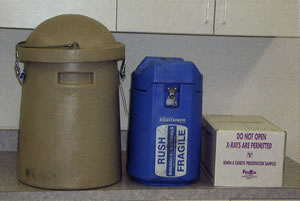 The
advent of shipped semen technology has drastically changed the horse breeding
business. In years past, a broodmare had to be transported to the stallion
in order to be bred. This involved considerable risk, expense and inconvenience
to the mare owner. Consequently, many mare owners chose to breed their mare
to a stallion within a relatively short distance of their farm, sometimes
having to overlook faults in quality and greatly limiting their choice of
stallions. Transported semen, whether cooled or frozen, has allowed the breeder
to select from stallions anywhere in the world. As a result, the overall quality
of foals produced has improved greatly as breeders become more educated in
a breeding market which has become highly competitive and specialized.
The
advent of shipped semen technology has drastically changed the horse breeding
business. In years past, a broodmare had to be transported to the stallion
in order to be bred. This involved considerable risk, expense and inconvenience
to the mare owner. Consequently, many mare owners chose to breed their mare
to a stallion within a relatively short distance of their farm, sometimes
having to overlook faults in quality and greatly limiting their choice of
stallions. Transported semen, whether cooled or frozen, has allowed the breeder
to select from stallions anywhere in the world. As a result, the overall quality
of foals produced has improved greatly as breeders become more educated in
a breeding market which has become highly competitive and specialized.
Cooled-shipped semen is collected and evaluated according
to the above method and diluted into extenders specially formulated for maintaining
the spermatozoa for up to 72 hours. A minimum of 1 billion progressively motile
spermatozoa should be provided in each insemination dose, allowing for some
loss during transit. The semen is packaged into a shipping container which
has been designed to cool the semen slowly from 37 degrees C to approximately
5 degrees C over a period of 8 hours. The "industry standard" is
the Equitainer, a very durable unit meant for use
over many years, costing around $350.00. More recently, disposable units have
become available and are adequate for most stallion's semen. They are designed to be used a limited number
of times (generally 5) and are considerably less expensive to purchase and
transport. The semen is transported to the mare via overnight or same-day
delivery and inseminated upon arrival. Insemination should occur within 12-24
hours prior to ovulation. Shipped semen conception rates vary among stallions
but are, overall, quite good in a well managed program. When considering breeding
your mare with shipped semen, it is important to ask the stallion owner/facility
about the stallion's shipped semen conception rates (per cycle), expected
motility at 24 and 48 hours after collection, and charges associated with
collection, packaging and shipment. A reputable facility should be willing
to provide references.
Also, sending your mare to a good receiving station to manage
the breeding will improve your chances of success.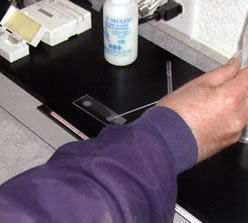
Stallion semen may be frozen and stored at very low temperature
for an extended period of time. It is stored submersed in liquid nitrogen
at -196 C, a temperature so low that metabolic reactions in the spermatozoa
occur at an extremely slow rate. In essence, the spermatozoa are kept in a
state of suspended animation. The term "frozen" is not completely
accurate to describe the state of the cells. Rather, the cytoplasm of the
sperm cell has been treated with a cryoprotectant
—a sort of antifreeze— which prevents the contents of the cell from truly
solidifying. Without the cryoprotectant, the expansion
forces due to freezing would shear intracellular structures as well as the
cell membrane which surrounds them, destroying the cell and rendering the
semen useless. These cryoprotectants and membrane
stabilizers are contained in a number of specialized extenders formulated
specifically for freezing semen. The methods used to freeze equine semen are
highly technical, necessitating very specialized equipment and instrumentation.
Protocols dictate very precise handling methods, packaging, cooling and thawing
rates and temperatures. Even for those who do it frequently, there is a sense
of awe when a dose of frozen semen is thawed and the previously inanimate
cells come to life under a microscope, resuming their mission completely unaware
that they have been frozen for many months or years.
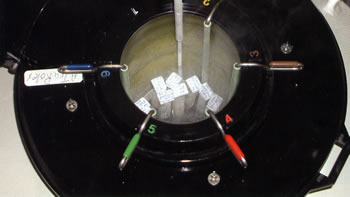
Conception rates with frozen semen are generally lower than
with fresh or cooled semen. The rigors of the freezing and thawing process
invariably result in the loss of a portion of the motile spermatozoa. Post-thaw
motility rates in the 40%-50% range are likely, with rates above 60% considered
above-average. Also, most frozen semen has a decreased longevity in the mare's
reproductive tract after insemination, requiring a more
exacting breeding protocol.
Best results are seen when a mare is inseminated within a 4
to 6 hour window around ovulation. hCG
is often administered to better control/predict the timing of ovulation. An
average of two cycles per pregnancy should be expected, though fertility is
variable among stallions. For this reason, frozen semen is most often used
when a stallion is unavailable due to injury or death,
he resides in a foreign country, or has a busy show schedule during the breeding
season.
Embryo Transfer
Embryo transfer (ET) entails the collection of a 7-8 day old
embryo from a "donor" mare's uterus and transferring it into the
uterus of a reproductively sound "recipient" mare. The cycles of
the donor and recipient are synchronized with one another, often through the
use of the above-mentioned hormonal modulation techniques. Once in estrus,
the donor mare's cycle is not managed any differently than if she was to carry
the foal on her own. However, at 7-8 days after ovulation, her uterus is flushed
with several liters of an embryo collection medium with the fluid recovered
and filtered through a very fine mesh which traps the embryo. At this time
point in development, the embryo is an "expanded blastocyst"
and is 500-1500 microns (0.5-1.5 mm) in diameter. The filtered fluid is searched
under high magnification for the embryo which is then transferred into a special
holding medium, where it will remain until transferred into the recipient.
Embryo recovery rates are quite high (approximately 75% per attempt) when
a fertile mare is bred to a fertile stallion, Problem mares will yield embryos
at a lower rate depending upon their unique reproductive profile.
Once identified, the embryo is transferred, either surgically
or non-surgically through the cervix, into the recipient's uterus. Most embryo
transfer facilities currently use the non-surgical transfer procedure due
to its greater ease and good rate of success (approximately 75-80% per transfer).
Recipient mares are often given supplemental progesterone
after the transfer, improving the chances of success.
The recipient mare makes no genetic contribution to the developing
foal, though her size can impose limits on the growth of the foal in utero.
Studies have shown that embryos derived from large breeds transferred into
smaller breed recipients may result in foals which are smaller at birth than
they might have been, otherwise. However, the consensus is that these foals
will "catch up" to their genetic potential. Regardless, an effort
is made to more closely match donor and recipient size.
Embryo transfer is an excellent means of obtaining multiple
foals from a donor mare and several registries now allow registration of more
than one foal from a mare in a single season. "Superovulation"
techniques allow breeders to collect and transfer multiple embryos from a
mare on a single cycle—
Oocyte Transfer
A variation on the embryo transfer theme is oocyte transfer. Ooctye (egg) collection
involves the use of an ultrasound-guided needle to puncture the donor's preovulatory
follicle. The contents of the follicle, ideally including the egg, are then
aspirated into a collection bottle and searched under high magnification for
the oocyte. Equine oocytes
are quite small (100 microns or 0.1 mm in diameter) and the search and handling
process is a delicate one.
Once recovered, the oocyte is surgically
transferred into the oviduct of
Equine oocyte transfer is a relatively
new offering for the breeder, available commercially since 1995. Pregnancy
rates have improved considerably and approach those of embryo transfer. It
is a very valuable tool for obtaining foals from mares which are incapable
of producing an embryo (due to oviductal blockages)
or whose uterine environment is incapable of sustaining an embryo to the 7-8
day time-point when an embryo can be collected.
New Horizons
Much of the current research in equine assisted reproduction
focuses on commercially viable methods for freezing equine embryos and oocytes for later transfer, separation of X and Y chromosome
bearing spermatozoa for controlling the sex of the foal, in vitro fertilization,
and even cloning. Likewise, basic scientific research is ongoing in the effort
to better understand, at the molecular and cellular level, how horses reproduce.
Brad Ray, M.S. is general manager of Premier Breeding Services,
LLC in Sedalia, CO. He earned a bachelor's degree in Molecular, Cellular,
and Developmental Biology from the University of Colorado, Boulder and a master's
degree in Reproductive Physiology from Colorado State University, where he
was general manager of the Equine Reproduction Laboratory. He has worked in
private industry since 1995. During the "off-season ", he operates
a mobile laboratory offering stallion semen freezing services nationwide as
well as breeding management consultation services.
He can be contacted at: Premier Breeding Services
303-681-9717 (lab) 719-240-1598 (cell) 5501 West Dakan Rd.,
GLOSSARY
atresia
loss of function, regression
cytoplasm
fluid within the cell confined by
the cell membrane or wall (bacteria); contains the components for, and acts as
the environment in which, the biochemical reactions necessary to cell function
can occur :
endocrinology
the study of hormones and their physiologic actions.
expanded blastocyst
an early embryonic developmental
stage in which the embryo consists of a hollow sphere of cells (the trophoblast) and includes a small cluster of cells which
will ultimately develop into the fetus.
human chotionic
gonadotropin (hCG)
a hormone produced by the human chorion (a fetal tissue) which can be administered to mares
to initiate follicle maturation and ovulation.
lutealytic
agent
an agent capable of causing "luteolysis" or j regression of luteal
tissue. The luteal:
tissue of the corpus luteum is responsible for the
production of progesterone during the diestrus phase
of a mare's cycle.
luteinizing
hormone (LH)
a reproductive hormone, produced by
the anterior pituitary, which, in the female, triggers maturational changes in
the ovarian follicle and oocyte during late estrus.
motility
a term which connotes the ability
to move; "progressive" motility implies movement with clear direction
and purpose.
oocyte
unfertilized egg/ovum
oviduct
or fallopian tube; the passageway
through which the egg travels, after ovulation, to reach the uterus
progesterone
a reproductive hormone, produced by
the corpus luteum during diestrus
and early pregnancy. Though it acts on many tissue types, one of its principle
functions is to increase uterine and cervical tone through smooth muscle
contraction. Both are important in maintaining pregnancy.
superovulation
a term used to describe the hormonal
super-stimulation of the ovary to cause the production of a greater than normal
number of ovarian follicles and ovulations.
